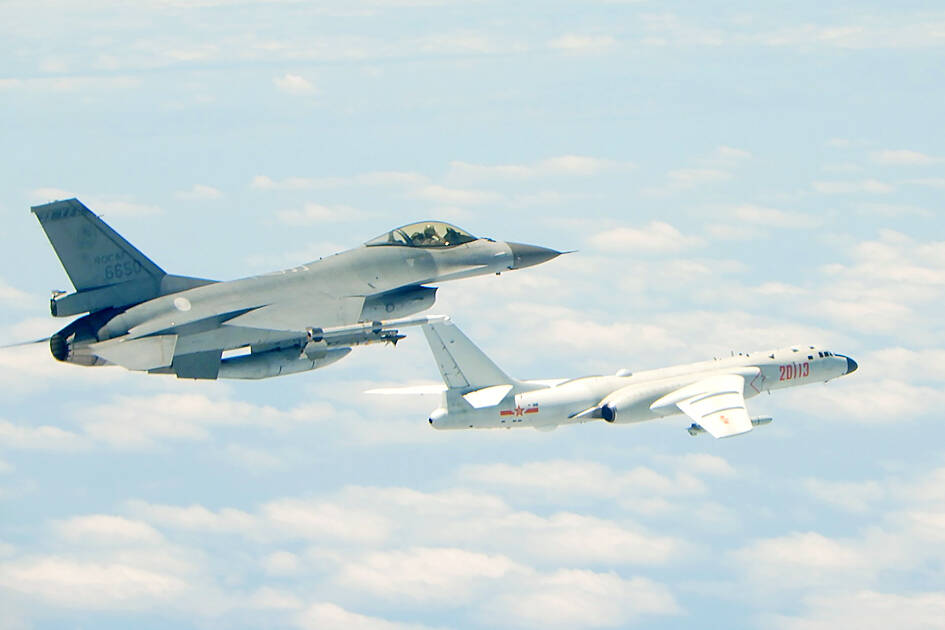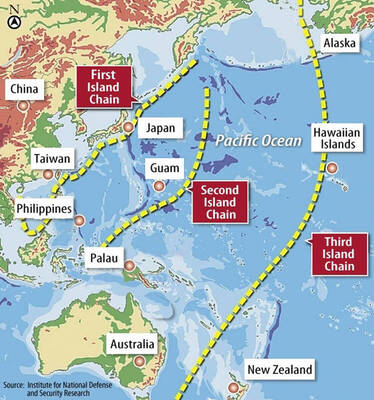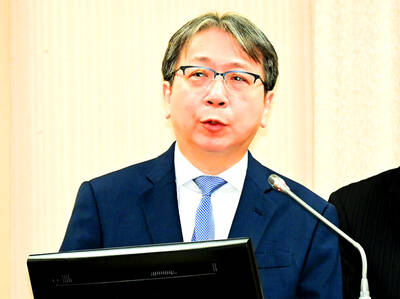The Chinese People’s Liberation Army Air Force last month made 446 incursions into Taiwan’s air defense identification zone (ADIZ), the Defense Post reported on Thursday.
Last month’s incursions far surpassed the number recorded during the whole of 2020, the report said.
“The median line [of the Taiwan Strait] has long been seen as a way to avoid conflict, but China has begun whittling away at it,” Bonnie Glaser, director of the Asia program at think tank the German Marshall Fund of the US, was cited by Voice of America as saying in a report on Friday.

Photo: AFP / The Ministry of National Defense
China would likely conduct more exercises with the aim of “narrowing Taiwan’s operating space and calling into question its claim to an ADIZ and an [exclusive economic zone],” the report quoted her as saying.
Putting last month’s 446 incursions into context, the report cited publicly available information from the Taiwan ADIZ Violations Tracker database showing that there were only 23 such incursions between September 2020 and July 31.
“They are seeking to wear down Taiwan’s pilots and maintenance crews and instill a sense of psychological despair among the population,” Voice of America quoted Glaser as saying.
Crystal Tu (杜貞儀), assistant research fellow at the Institute for National Defense and Security Research, said that despite US House of Representatives Speaker Nancy Pelosi’s visit to Taiwan on Aug. 2 and 3 — which China has used as an excuse for the incursions — China would eventually have ramped up its military exercises anyway.
The visit was merely a “trigger,” pushing China to do so sooner, she said.
In related news, a military source in Taipei yesterday said that the army plans to hold live-fire exercises in southern Taiwan this week that would test the combat capabilities of its various units.
The Eighth Army Corps would hold the regular Lien Yung drill in Pingtung County’s Joint Operations Training Base Command from tomorrow to Friday, said the source, who asked to remain anonymous.
The army’s Combined Arms Battalion, snipers, tanks, armored vehicles and mortars would be tested during the four-day live-fire exercises, the source said.
The Aviation and Special Forces Command would also dispatch AH-64E Apache and AH-1W Super Cobra helicopters to join the exercises, the source added.
The Lien Yung drill is normally held six times a year. It is the armed forces’ second-largest drill, following the annual Han Kuang exercises that involve all branches of the military.

The US government has signed defense cooperation agreements with Japan and the Philippines to boost the deterrence capabilities of countries in the first island chain, a report by the National Security Bureau (NSB) showed. The main countries on the first island chain include the two nations and Taiwan. The bureau is to present the report at a meeting of the legislature’s Foreign Affairs and National Defense Committee tomorrow. The US military has deployed Typhon missile systems to Japan’s Yamaguchi Prefecture and Zambales province in the Philippines during their joint military exercises. It has also installed NMESIS anti-ship systems in Japan’s Okinawa

TRAGEDY STRIKES TAIPEI: The suspect died after falling off a building after he threw smoke grenades into Taipei Main Station and went on a killing spree in Zhongshan A 27-year-old suspect allegedly threw smoke grenades in Taipei Main Station and then proceeded to Zhongshan MRT Station in a random killing spree that resulted in the death of the suspect and two other civilians, and seven injured, including one in critical condition, as of press time last night. The suspect, identified as a man surnamed Chang Wen (張文), allegedly began the attack at Taipei Main Station, the Taipei Fire Department said, adding that it received a report at 5:24pm that smoke grenades had been thrown in the station. One man in his 50s was rushed to hospital after a cardiac arrest

‘WIN-WIN’: The Philippines, and central and eastern European countries are important potential drone cooperation partners, Minister of Foreign Affairs Lin Chia-lung said Minister of Foreign Affairs Lin Chia-lung (林佳龍) in an interview published yesterday confirmed that there are joint ventures between Taiwan and Poland in the drone industry. Lin made the remark in an exclusive interview with the Chinese-language Liberty Times (the Taipei Times’ sister paper). The government-backed Taiwan Excellence Drone International Business Opportunities Alliance and the Polish Chamber of Unmanned Systems on Wednesday last week signed a memorandum of understanding in Poland to develop a “non-China” supply chain for drones and work together on key technologies. Asked if Taiwan prioritized Poland among central and eastern European countries in drone collaboration, Lin

ON ALERT: Taiwan’s partners would issue warnings if China attempted to use Interpol to target Taiwanese, and the global body has mechanisms to prevent it, an official said China has stationed two to four people specializing in Taiwan affairs at its embassies in several democratic countries to monitor and harass Taiwanese, actions that the host nations would not tolerate, National Security Bureau (NSB) Director-General Tsai Ming-yen (蔡明彥) said yesterday. Tsai made the comments at a meeting of the legislature’s Foreign Affairs and National Defense Committee, which asked him and Minister of National Defense Wellington Koo (顧立雄) to report on potential conflicts in the Taiwan Strait and military preparedness. Democratic Progressive Party (DPP) Legislator Michelle Lin (林楚茵) expressed concern that Beijing has posted personnel from China’s Taiwan Affairs Office to its